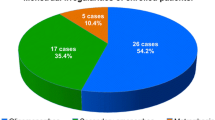Abstract.
Objective: The purpose of this study was to examine the effects of of bromocriptin combined with clomiphene citrate in clomiphene-resistant patients with polycystic ovary syndrome and normal prolactin level. Design: Prospective, double-blind, controlled study. Setting: University teaching hospital. Patients: One hundred polycystic ovary patients and normal prolactin (PRL) who were clomiphene citrate resistant. Interventions: Treatment group received 150 mg clomiphene citrate on days 5–9 and 7.5 mg bromocriptin continuously. Control group received the same protocol of clomiphene citrate combined with placebo. Main outcome measures: Hormonal status, follicular monitoring, ovulation rate. Results: Follicular development (follicular size greater than 15 mm) was observed in 12 (25.5%) and eight (15.1%) women in treatment and placebo group respectively (P=0.29). The serum prolactin level was within normal limits in all patients before treatment. After 3 and 6 months of treatment with bromocriptin, there was a significant decrease in serum level of prolactin (P=0.000001).No any significant differences was seen in ovulation, and serum levels of follicle-stimulating hormone (FSH), luteinizing hormone (LH), dehydroepiandrosterone sulfate (DHEAS), progesterone (P) between treatment and placebo group after treatment. Conclusions: The only significant effect of long-term bromocriptin therapy in clomiphene citrate resistant polycystic ovary women was to lower the serum prolactin concentration. It was also concluded that 10–15% of patients with polycystic ovaries experienced occasional ovulatory cycles and pregnancy whether or not they were on treatment.
Similar content being viewed by others
Change history
23 December 2023
This article has been retracted. Please see the Retraction Notice for more detail: https://doi.org/10.1007/s00404-023-07330-z
References
Branigan EF, Estes MA (1999) Treatment of chronic anovulation resistant to clomiphene citrate(CC) by using oral contraceptive ovarian suppression followed by repeat CC treatment. Fertil Steril 71:544–546
Buvat J,Buvat-Herbaut M, Marcolin G, Racadot A, Fourlinnie JC, Beuscart R, Fossati P (1986) A double blind controlled study of the hormonal and clinical effects of bromocriptin in the polycystic ovary syndrome. Clin Endocrinol Metab 63:119–124
Carmina E, Rosato F, Maggiore M, Gagliano AM, Indovina D, Janni A (1984) Polycystic secretion in polycystic ovary syndrome: Correlation with the steroid pattern. Acta Endocrinol 105:99–104
Chapman AJ, Wilson MD, Obhari M, Sawers RS, Lynch SS, Royston JP, Clayton RN (1987) Effects of bromocriptin on LH pulsatility in the polycystic ovary syndrome. Clin Endocrinol 27:571–580
Corenblum B, Taylor PJ (1980) A rational for the use of bromocriptin in patients with amenorrhea and normoprolactinemia. Fertil Steril 34:239–241
Ergur A (1998) Clomiphene citrate resistant polycystic ovary syndrome. J Reprod Med 43:185–190
Falashi P, Del Pozo E (1986) Inhibitory effect of bromocriptine treatment on luteinizing hormone secretion in polycystic ovary syndrome. J Clin Endocrinol Metab 62:348–351
Falashi P, Del Pozo E, Rocco A, Toscano V, Petrangeli E, Pompei P, Frajese J (1980) Prolactin release in polycystic ovary. Obstet Gynecol 55:579–582
Futterweit W, Krieger DT (1979) Pituitary tumors associated with hyperprolactinemia and polycystic ovarian disease. Fertil Steril 31:608–613
Kaptien EM, Kletzky DA, Spencer CA, Noolof JT (1980) Effects of prolonged dopamine infusion on anterior pituitary function. JCE & M 43:488–491
Kubota T, Kamada S, Aso T (1992) Combined therapy with bromocriptine and clomiphene citrate for patients with normoprolactinemic amenorrhea. Int J Fertil 37:277–282
Lunde O (1981) Hyperprolactinemia in polycystic ovary syndrome. Ann Chir Gynaecol 70:197–201
Marco C (1998) Effects of clomiphene citrate on androgens in polycystic ovary syndrome. Archiv Gynecol Obestet 261:117–120
Mitwally FM, Casper RF (2001) Use of aromatase inhibitor for induction of ovulation in patients with an inadequate response to clomiphene citrate. Fertil Steril 75:350–359
Peilon F, Vincens M, Ceselin F, Doumit R, Mouszowics I (1982) Exaggerated prolactin response to thyrotropin-releasing hormone in women with anovulatory cycles: Possible role of endogenous estrogens and effect of bromocriptine. Fertil Steril 37:530–535
Prelevic GM, Wurzburger MI, Peric LA (1987) Acute effects of L-dopa and bromocriptin on serum PRL, LH and FSH levels in patients with hyperprolactinemic and normoprolactinemic polycystic ovary syndrome. J Endocrinol Invest 10:389–395
Rosato P, Minto F, Garrone S, Ragni N (2000) Growth hormone response to clomiphene in anovulatory infertile women resistant to clomiphne citrate stimulation. Fertil Steril 73:78–84
Siginami H, Hamada K, Yano K, Kuroda G (1986) Ovulation induction with bromocriptin in noroprolactinemic anovulatory women. JCE & M 62:899–903
Speroff L, Glass RH, Kase NG (1999) Anovulation and the polycystic ovary syndrome. Clinical gynecologic endocrinology and infertility, 6th edn. Williams and Wilkins, Baltimore, pp 487–521, 1105
Spruce BA, Kenedal Taylor P, Donlope W, Anderson AJ, Watson MJ, cook DB et al (1984) The effect of bromocriptin in the polycystic ovary syndrome. Clin Endocrinol 20:481–488
Steingold KA, Lobo RA, Judd HL, Lu JK, Chang RJ (1986) The effect of bromocriptin on gonadotropin and steroid secretion in polycystic ovarian disease. Clin Endocrinol Metab 62:1048–1051
Takakura K, Taii S, Ihara Y, Takai I, Mori T (1989) Aggravation of inappropriate lutenizing hormone secretion by bromocriptin in polycystic ovary syndrome with elevated serum DEHAS. Endocrinol Jpn 36:261–268
Worstman J, Hirschowitz JS (1980) Galactorrhea and hyperprolactinemia during treatment of polycystic ovary syndrome. Obstet Gynecol 55:460–463
Acknowledgements.
We would like to gratefully acknowledge Professor Ernst Heinrich Schmidt, Chairman of the Obstetrics and Gynecology Department, Diako Hospital, Bremen Germany for his technical help and advices.
Author information
Authors and Affiliations
Corresponding author
Additional information
This work was performed at the Division of Infertility, Department of Obstetrics and Gynecology, School of Medicine, Shiraz University of Medical Sciences, Shiraz, Iran.
About this article
Cite this article
Parsanezhad, M.E., Alborzi, S. & Namavar Jahromi, B. RETRACTED ARTICLE: A prospective, double-blind, randomized, placebo-controlled clinical trial of bromocriptin in clomiphene-resistant patients with polycystic ovary syndrome and normal prolactin level. Arch Gynecol Obstet 269, 125–129 (2004). https://doi.org/10.1007/s00404-002-0437-x
Received:
Accepted:
Published:
Issue Date:
DOI: https://doi.org/10.1007/s00404-002-0437-x




